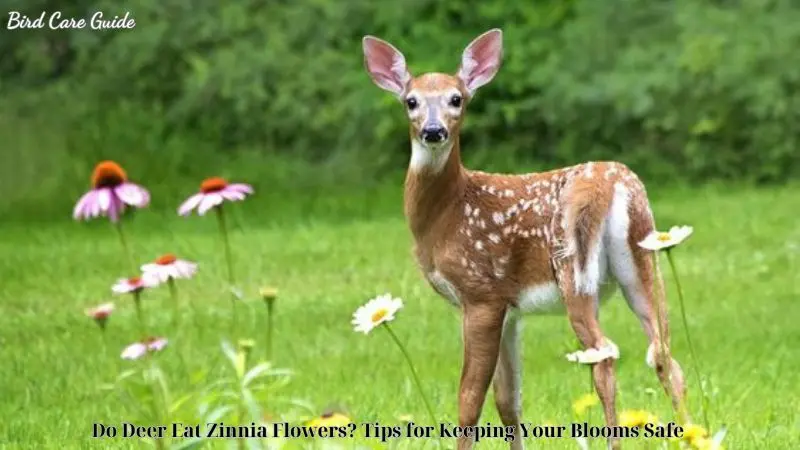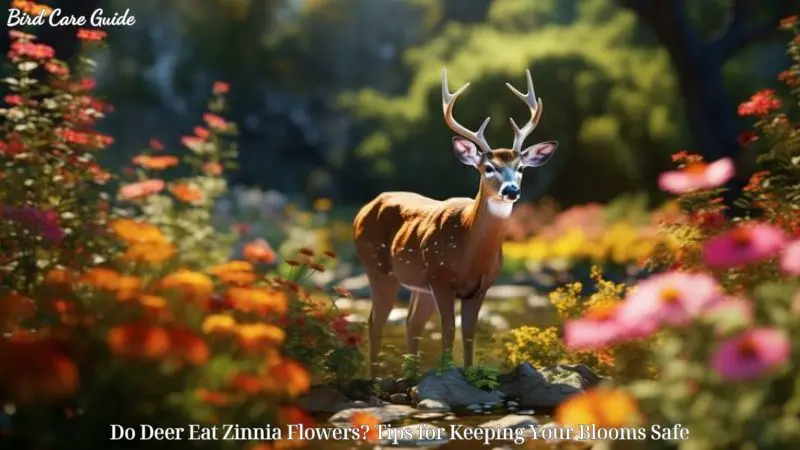Zinnia flowers are a vibrant and colorful addition to any garden, known for their bright hues and long-lasting blooms. However, gardeners often face the challenge of protecting these beautiful flowers from various garden pests, including deer. The question “Do deer eat zinnia flowers?” is a common concern for many garden enthusiasts.
This article “Bird Care Guide” will explore the feeding habits of deer, especially their attraction to Zinnias, and provide tips for keeping your Zinnias safe from these omnivores .
Table of contents
ToggleUnderstanding Deer Behavior
Diet and Feeding Habits
Deer are herbivores, primarily feeding on a variety of plants. Their diet consists of grasses, leaves, twigs, fruits, and flowers. The specific diet of a deer can vary based on the season and the availability of food. During spring and summer, deer tend to eat a lot of fresh greens and flowering plants. In contrast, during fall and winter, their diet shifts to more woody plants and fallen fruits as other food sources become scarce.
Attraction to Gardens
Gardens often present an irresistible buffet for deer, offering a variety of tender, nutritious plants that are easy to access. Flowers, in particular, can be very appealing to deer due to their scent, taste, and the moisture content they provide. Zinnias, with their vibrant colors and soft petals, can be especially attractive.
Do Deer Eat Zinnia Flowers?

While deer are known to eat a wide range of plants, they do not typically prefer zinnias. Zinnia flowers have a somewhat bitter taste and a coarse texture that can be unappealing to deer. However, this does not mean that zinnias are entirely deer-proof. In areas where food is scarce or deer populations are high, these animals may still nibble on zinnia flowers out of necessity.
Factors Influencing Deer Feeding on Zinnias
Several factors can influence whether deer will eat zinnia flowers in your garden:
- Availability of Food: If there are plenty of other more palatable plants available, deer are less likely to eat zinnias.
- Deer Population Density: In areas with high deer populations, competition for food can lead deer to consume less preferred plants, including zinnias.
- Seasonal Changes: During times when natural food sources are limited, such as late winter or early spring, deer may be more inclined to eat a wider variety of plants, including zinnias.
- Garden Proximity to Deer Habitat: Gardens located near forests, woodlands, or other deer habitats are more likely to experience deer browsing.
Tips for Keeping Your Zinnia Blooms Safe
Given that deer might occasionally eat zinnia flowers, especially under certain conditions, it is essential to take measures to protect your garden. Here are some effective tips for keeping your zinnia blooms safe from deer:
1. Use Deer-Resistant Plants
One of the best ways to deter deer from eating your zinnias is to incorporate deer-resistant plants into your garden. Plants that are known to repel deer due to their strong scent, taste, or texture include:
- Lavender
- Marigolds
- Daffodils
- Yarrow
- Foxglove
Planting these around your zinnias can create a natural barrier that makes it less likely for deer to venture close to your flowers.
2. Install Physical Barriers
Physical barriers can be highly effective in preventing deer from accessing your garden. Options include:
- Fencing: A tall fence, at least 8 feet high, can effectively keep deer out. For added security, consider an electric fence or a double-layered fence system.
- Netting: Lightweight netting can be draped over your zinnias to protect them from being eaten. Ensure the netting is secured to prevent deer from pushing it aside.
- Cages: Individual plant cages or cloches can protect specific plants or small groups of plants from deer browsing.
3. Apply Deer Repellents
Deer repellents can deter deer from eating your zinnias by making the plants taste or smell unpleasant. There are various types of repellents available:
- Scent-based repellents: These use strong odors, such as garlic, peppermint, or predator urine, to repel deer.
- Taste-based repellents: These make the plants taste bitter or spicy, deterring deer from eating them.
- Commercial repellents: Products specifically designed to repel deer, such as Liquid Fence or Deer Off, can be effective when applied regularly.
It’s important to reapply repellents after rain or heavy watering, as they can wash off.
4. Use Motion-Activated Deterrents
Motion-activated deterrents can startle deer and discourage them from entering your garden. Options include:
- Sprinklers: Motion-activated sprinklers release a burst of water when they detect movement, scaring deer away.
- Lights: Motion-activated lights can startle deer, especially at night when they are most active.
- Sound devices: Motion-activated sound devices emit loud noises that can frighten deer and deter them from approaching.
5. Maintain Your Garden
Keeping your garden well-maintained can also help deter deer. Remove fallen fruit, vegetables, and flowers that might attract deer. Trim back overgrown plants and bushes that can provide cover for deer. Additionally, consider installing gravel or stone pathways, as deer are less likely to walk on these surfaces.
Advanced Strategies for Deer Prevention
For those who find that basic strategies are not sufficient, here are some advanced techniques to further safeguard your zinnia flowers from deer.
1. Rotating Repellents
Deer can become accustomed to certain repellents if used continuously. Rotating between different types of repellents can prevent deer from getting used to any one scent or taste. This strategy keeps them guessing and increases the overall effectiveness of the repellents.
2. Companion Planting
Companion planting involves growing plants that deter deer alongside your zinnias. For example, planting garlic, onions, or chives can help keep deer away due to their strong odor. Companion planting not only protects your zinnias but also enhances the overall health and diversity of your garden.
3. Creating a Multi-Sensory Deterrent Environment
Deer are cautious animals, and creating a multi-sensory deterrent environment can effectively keep them at bay. Combining visual, auditory, and olfactory deterrents creates a hostile environment for deer. For instance:
- Visual Deterrents: Reflective tapes, garden spinners, and scare balloons.
- Auditory Deterrents: Wind chimes, radio noise, or ultrasonic deer deterrent devices.
- Olfactory Deterrents: Scented soap bars, human hair, or commercial deer repellents.
4. Regular Garden Maintenance
Maintaining a tidy garden can also help deter deer. Overgrown and dense vegetation provides hiding spots and makes it easier for deer to navigate your garden. Regularly trimming and maintaining your garden reduces these hiding spots and makes your garden less appealing to deer.
Conclusion
The question “Do deer eat zinnia flowers?” is met with a definitive yes, as deer are known to enjoy these colorful and tender blooms. However, with a proactive and strategic approach, gardeners can protect their zinnias and enjoy a flourishing garden.
By understanding deer dietary habits and implementing a combination of fencing, deer-resistant plants, repellents, motion-activated devices, physical barriers, and scare tactics, you can create an environment that deters deer and keeps your zinnias safe. Gardening in deer-prone areas may present challenges, but with the right strategies, you can successfully coexist with these graceful animals while preserving the beauty of your garden.





